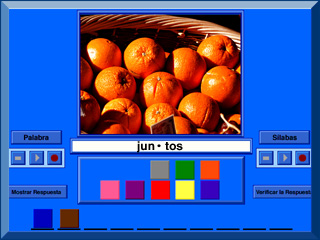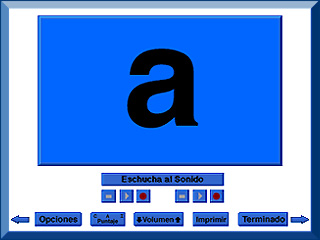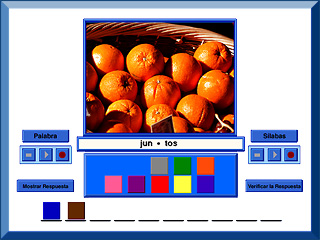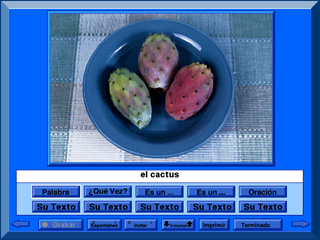
Practice word finding skills using real photographs of food, household objects, animals and other objects that we see everyday.
Target Audience: Appropriate for Spanish-speaking children (L-1) ages 3-8 with impaired speech intelligibility. Based on Spanish Phonological Sound system not a Translation of English. Also appropriate for Spanish speaking children with Autism, PDD, Down Syndrome, Cerebral Palsy, and Language Delay.
“Es ...” Todo
by LocuTour Multimedia
Windows Only
Information for Professionals:
“Es...” Todo is a Spanish version of “It’s a...” Bundle. It includes “It’s a...” Food, “It’s a...” Animals, and Spanish language version of ABC. This version of And a One, Two, Three! has two to ten syllables to practice syllable segmentation in Spanish.

ABC (Español) allows clients to learn the Spanish alphabet and the 46 Spanish speech sounds.
ABC does not need to be played in its entirety. The most important aspect of this game is What’s My Sound?. This game will put each letter on the screen and tell you what sound that letter makes.
This task is designed to prepare the client for letter and word recognition tasks found on other LocuTour titles. This game establishes the rules for consonant and vowel sounds utilized in the other games.
Use the Options menu to make the letters appear in random order so that the sounds are spoken out of sequence. If you turn off the sound it becomes a flashcard naming game.

¡Uno, Dos, y Tres! is a great tool for stimulating auditory processing and expressive language.
¡Uno, Dos, y Tres! works on syllable segmentation. Words from the English And a One, Two, Three! were translated into words and phrases in Spanish. The student listens to the word, determines the number of syllables and puts the correct number of colored blocks on the line. The Sílabas (Syllables) button pronounces the word in syllable chunks for speech practice and syllable segmentation practice.
The Show Answer button puts the correct number of colored blocks on the dashed line and the computer says the word with distinct pauses between the syllables. Students can use the two sets of recording buttons to record their voice and compare their production of the word or phrase with ours. A homework page, with the picture and the word, can be printed out so students can practice at home. Sample vocabulary words are:
| rojo | 2 syllables |
| el pollo | 3 syllables |
| el oso | 3 syllables |
| el cachorro | 4 syllables |
| el papagayo | 5 syllables |
| la lagartija | 5 syllables |
| la cuesta abajo | 6 syllables |
| el pony pastando | 6 syllables |
| una fila de casas | 7 syllables |
| la barra de chocolate | 8 syllables |

“Es... Animales” has 120 pictures of animals in their habitats.
House; Ranch/Farm; Forest; Mountain; Desert; Insects; River/Lake; Ocean; Africa; Jungle; Prairie/Grasslands; Tundra/Arctic The most basic photographic and written stimuli are of animals around the house. There is a hierarchical progression through animals that live in the jungles, oceans, and other habitats of the world to the final (12th) category of animals on the tundra or those in arctic weather. The one category that is not by habitat is the Insect category, since insects are in all habitats! There are 120 animals to talk about.
You will undoubtedly notice that some animals could be located in more than one habitat. While it was difficult to make a final determination, we chose the groupings based on where the photograph was taken and the logic of keeping animals in familiar settings, which should lead to easier recall of the word.

Full color photos of everyday food with word and sentence models designed to improve accuracy, fluency, and speed of word retrieval.
This program is a translated version of a “It’s a...” Food from the “It’s... a” Bundle. It features all of the pictures from the existing CD and 25 additional pictures of foods from Spanish speaking cultures.